TTEC Bundle
Who Does TTEC Serve? Unveiling the Customer Demographics and Target Market
In the ever-evolving landscape of customer experience (CX), understanding the TTEC SWOT Analysis and its target market is crucial. TTEC Holdings, Inc., a global leader in CX technology and services, thrives on deeply understanding its customer demographics and tailoring its offerings to meet their specific needs. But who exactly are these customers, and how does TTEC strategically position itself to serve them?
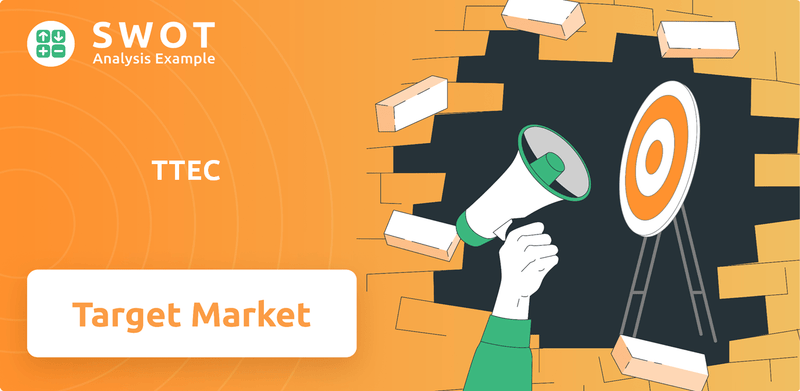
This exploration delves into the core of TTEC's customer profile, examining its target audience analysis and the industries it serves. We'll uncover the key factors that shape TTEC's business model, from its customer segmentation strategies to its customer acquisition strategies. Understanding the needs of TTEC's customers, their demographics, and psychographics is essential to grasping TTEC's competitive advantage in its target market and how it defines its target market.
Who Are TTEC’s Main Customers?
Understanding the primary customer segments is crucial for analyzing the Revenue Streams & Business Model of TTEC. The company operates primarily in a business-to-business (B2B) model, focusing on providing customer experience (CX) solutions. Therefore, the TTEC target market is not defined by individual consumer demographics like age or income, but rather by the characteristics of the businesses it serves.
The TTEC company's core customer base consists of large enterprises across various sectors. These include financial services, healthcare, telecommunications, retail, and government entities. These organizations typically face complex customer service challenges and are often seeking digital transformation, cost reduction, or enhanced brand reputation through improved customer experiences. Analyzing the customer demographics in this context means understanding the needs and strategic goals of these client businesses.
The company's business model is designed to cater to these specific needs. The company reported revenue of approximately $2.4 billion in 2023, with a significant portion derived from its CX solutions and digital transformation services. This revenue reflects the demand from its primary customer segments for advanced customer experience management.
These are companies looking to transition from traditional to digital customer engagement channels. They require the technological infrastructure and expertise that the company provides. This segment is experiencing rapid growth due to the increasing demand for online and mobile customer service solutions.
These businesses aim to improve customer satisfaction and build loyalty through personalized and seamless interactions. They often operate in competitive markets where superior customer experience is a key differentiator. The company's solutions help these clients achieve higher customer retention rates.
This segment includes businesses with large customer bases or fluctuating demand. They need scalable and efficient customer care solutions to manage peak times and ensure consistent service levels. The company's ability to provide flexible staffing and technology is crucial for these clients.
This segment includes sectors like healthcare, which is driven by evolving patient engagement models and data privacy regulations. These industries require sophisticated and compliant CX solutions. The company's expertise in these areas positions it well for growth.
The company's target audience analysis focuses on identifying businesses with specific needs related to customer experience. This includes their digital transformation goals, customer satisfaction metrics, and operational efficiency requirements. Understanding these needs allows the company to tailor its services effectively.
- Industry Focus: The company's customer base is concentrated in industries like financial services, healthcare, and telecommunications.
- Business Size: The company typically serves large enterprises with significant customer bases and complex operational needs.
- Strategic Goals: Clients often seek to improve customer satisfaction, reduce costs, and enhance their brand reputation.
- Technological Needs: Clients require advanced CX solutions, including digital engagement channels, data analytics, and automation.
TTEC SWOT Analysis
- Complete SWOT Breakdown
- Fully Customizable
- Editable in Excel & Word
- Professional Formatting
- Investor-Ready Format
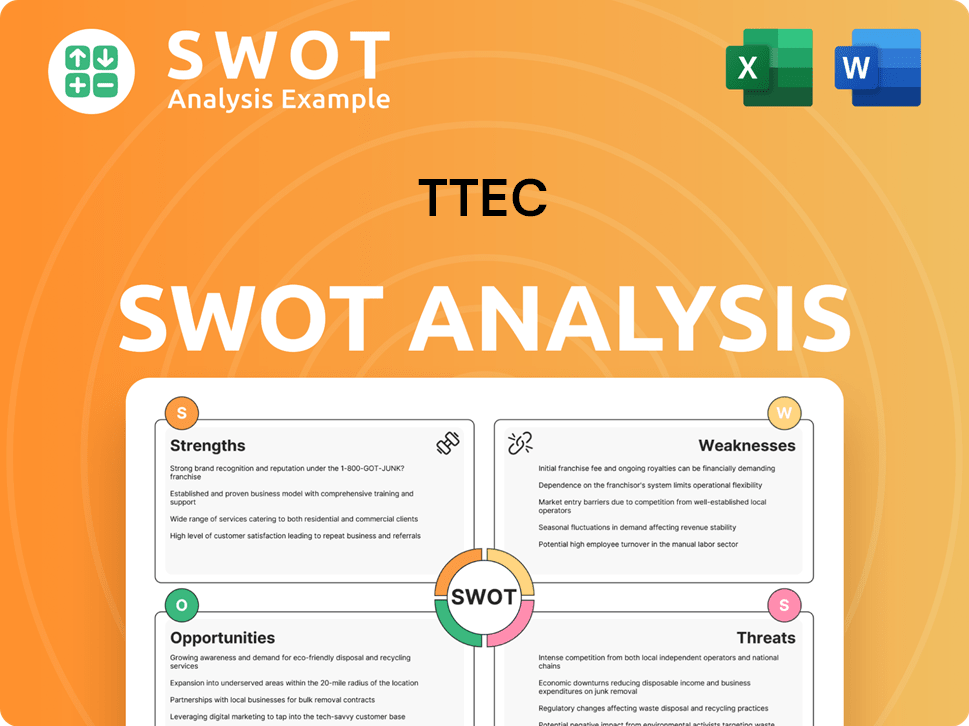
What Do TTEC’s Customers Want?
Understanding the customer needs and preferences is crucial for any business, and for the TTEC company, this involves a deep dive into the motivations of its B2B clients. These clients are primarily focused on enhancing their customer experiences and boosting operational efficiencies. The goal is to provide solutions that meet these specific needs, ensuring customer satisfaction and driving business growth.
The primary drivers for TTEC's B2B customers include improving customer satisfaction, reducing churn, increasing revenue, and optimizing operational costs. These clients seek seamless omnichannel interactions, enabling their end-customers to engage across various touchpoints. The decision-making process for clients often involves evaluating scalability, security, integration capabilities, and ROI.
The purchasing behavior of TTEC's clients typically involves lengthy sales cycles with multiple stakeholders, including IT, operations, and executive leadership. Clients value partners with industry expertise, a proven track record, and a strong understanding of their business challenges. Loyalty is built on consistent service, proactive problem-solving, and continuous innovation in CX technology.
Clients prioritize solutions that demonstrably improve customer satisfaction. This often involves implementing strategies to reduce customer effort and enhance overall experience. According to the 2024 American Customer Satisfaction Index (ACSI) report, customer satisfaction scores in the customer service sector are closely watched, reflecting the importance of this aspect.
Reducing customer churn is a key objective, as retaining existing customers is often more cost-effective than acquiring new ones. Strategies include personalized customer service and proactive issue resolution. Research from Bain & Company indicates that a 5% increase in customer retention can increase profits by 25% to 95%.
Clients aim to increase revenue through better sales and retention strategies. This involves providing sales teams with the tools and insights needed to close deals. Data from McKinsey shows that companies with superior customer experience generate 20% higher revenue growth.
Optimizing operational costs is a significant driver, with clients seeking solutions that improve efficiency and reduce expenses. Automation and AI-driven tools play a crucial role. According to a 2024 report by Deloitte, companies using AI in customer service can reduce operational costs by up to 30%.
Clients require solutions that offer seamless omnichannel interactions, allowing customers to engage across various touchpoints. This includes voice, chat, social media, and self-service portals. A 2024 study by Gartner indicates that companies with strong omnichannel strategies retain 89% of their customers, compared to 33% for those with weak strategies.
Scalability and security are critical decision-making criteria for clients. Solutions must be able to handle increasing volumes of interactions and protect sensitive customer data. The global cybersecurity market is projected to reach $345.7 billion by 2026, highlighting the importance of robust security measures.
TTEC addresses common pain points such as fragmented customer data, inefficient manual processes, and a lack of real-time customer insights. The company's focus on AI-powered solutions and analytics helps clients move beyond reactive customer service to predictive and personalized engagement, addressing the unmet need for proactive customer management. This approach is crucial in today's market, where customers expect personalized and proactive service.
- Fragmented Customer Data: TTEC offers integrated platforms to consolidate customer data.
- Inefficient Manual Processes: Automation tools streamline workflows.
- Lack of Real-Time Customer Insights: Advanced analytics provide actionable insights.
- Proactive Customer Management: AI-powered solutions enable predictive and personalized engagement.
TTEC PESTLE Analysis
- Covers All 6 PESTLE Categories
- No Research Needed – Save Hours of Work
- Built by Experts, Trusted by Consultants
- Instant Download, Ready to Use
- 100% Editable, Fully Customizable
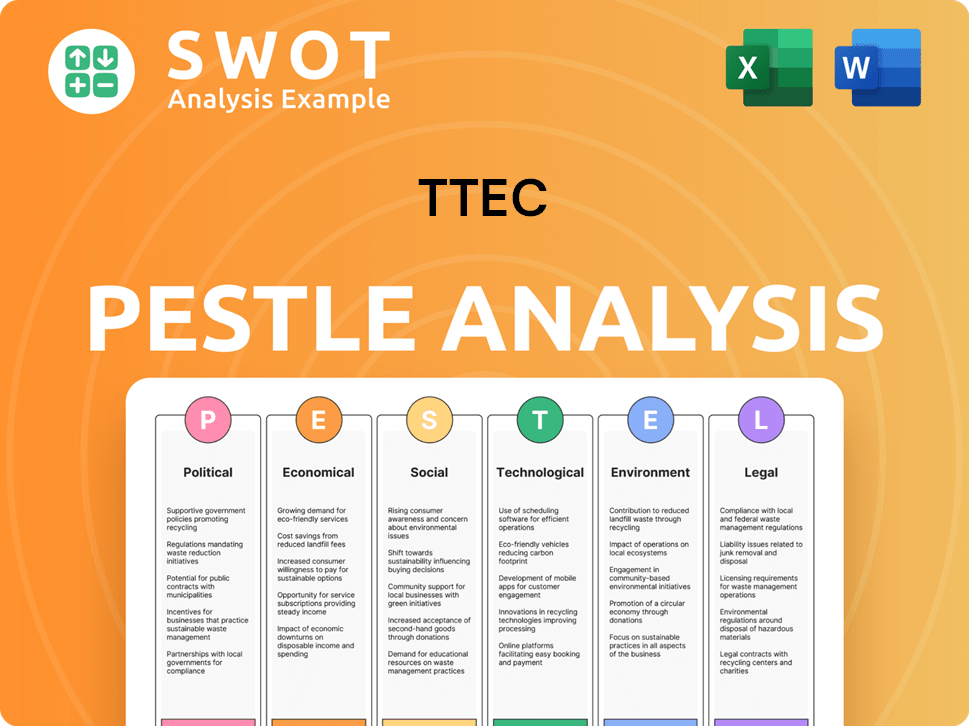
Where does TTEC operate?
The geographical market presence of the company is extensive, encompassing North America, EMEA (Europe, Middle East, and Africa), and APAC (Asia-Pacific). Its strong presence in North America, where it was founded, is a key aspect of its operational base. The company has strategically expanded to serve a diverse international clientele, recognizing the global nature of many of its enterprise clients.
Major markets include the United States, Canada, the United Kingdom, the Philippines, and Australia. This global reach requires a localized approach to address the varying customer demographics, preferences, and buying power across these regions. For example, customer service expectations and communication norms can vary significantly between Western and Asian markets, requiring the company to adapt its service delivery models and agent training accordingly.
The company localizes its offerings by establishing regional delivery centers and employing diverse workforces with local language capabilities. This approach allows it to tailor its marketing messages to resonate with specific cultural and business contexts. Recent expansions have focused on strengthening its presence in key growth markets, often through strategic partnerships or acquisitions that enhance its regional capabilities and market access. The geographic distribution of sales and growth reflects a balanced approach, with continued investment in mature markets while aggressively pursuing opportunities in emerging economies where digital CX transformation is gaining momentum.
The company's strongest market share and brand recognition are found in North America. This region serves as a foundation for its operations and a base for expansion. The company continues to invest in this mature market while exploring new opportunities.
The EMEA region is a significant market for the company, serving diverse clients across Europe, the Middle East, and Africa. The company adapts its service delivery models to meet the specific needs of each market. Customer service expectations and communication norms vary across the region.
The Asia-Pacific region represents a key area for growth, with increasing demand for sophisticated CX solutions. The company strategically expands its footprint to serve a diverse international clientele. The company has a balanced approach, with continued investment in mature markets while aggressively pursuing opportunities in emerging economies.
The company establishes regional delivery centers and employs diverse workforces with local language capabilities. This approach allows it to tailor its marketing messages to resonate with specific cultural and business contexts. The company adapts its service delivery models and agent training accordingly.
The company's major markets include the United States, Canada, the United Kingdom, the Philippines, and Australia. These markets are crucial for the company's global strategy. The company's customer acquisition strategies are tailored to the specific needs of each region.
- United States: A core market with a high demand for advanced CX solutions.
- Canada: Strong presence with a focus on customer service excellence.
- United Kingdom: Significant market share in the EMEA region.
- Philippines: A key location for delivery centers.
- Australia: Growing market with increasing demand.
To understand the company's global success, one can also explore the Growth Strategy of TTEC. This highlights the company's strategic approach to expanding its global footprint and adapting to local market needs.
TTEC Business Model Canvas
- Complete 9-Block Business Model Canvas
- Effortlessly Communicate Your Business Strategy
- Investor-Ready BMC Format
- 100% Editable and Customizable
- Clear and Structured Layout
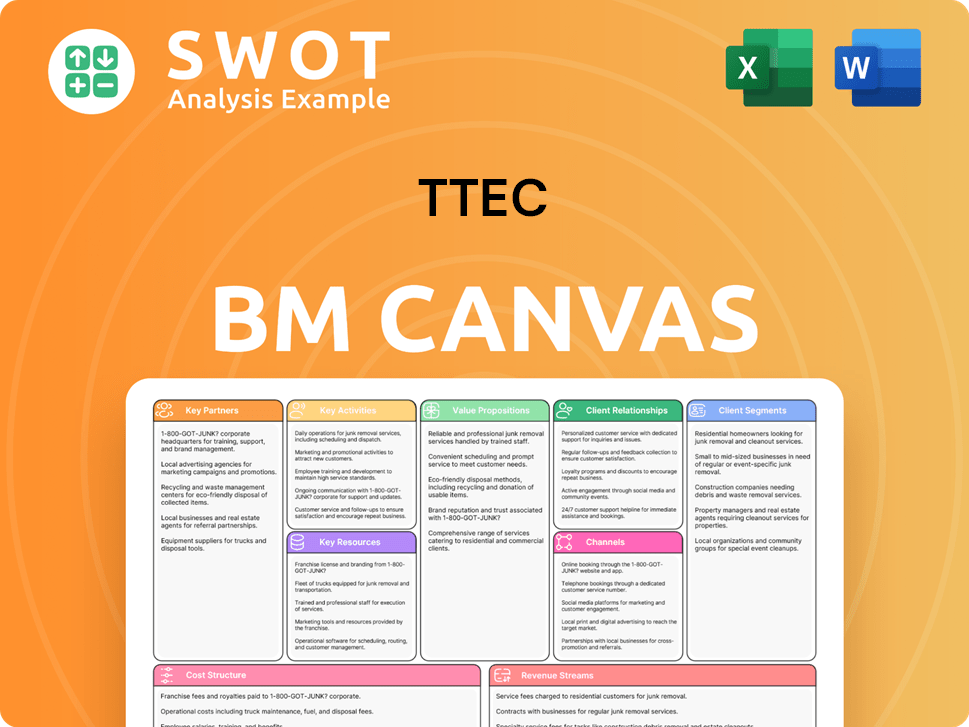
How Does TTEC Win & Keep Customers?
The company, a global customer experience (CX) technology and services provider, employs a multifaceted approach to customer acquisition and retention. Their strategies leverage both traditional and digital channels, alongside sophisticated data analytics and relationship management. Understanding the TTEC customer profile is critical for tailoring these strategies effectively. The company’s approach is designed to meet the evolving needs of its target market.
For customer acquisition, the company primarily uses direct sales, strategic partnerships, and targeted marketing campaigns. Their sales teams engage directly with large enterprises, often employing a consultative selling approach. Marketing efforts include industry conferences, webinars, thought leadership content like whitepapers, and digital marketing. Referrals from satisfied clients also play a significant role in attracting new business. They focus on acquiring clients within specific industries and of a certain size, aiming to maximize the value of each relationship.
Customer retention is a priority, given the long-term nature of client relationships. The company emphasizes delivering exceptional service quality, proactively addressing client needs, and demonstrating continuous value. They have shifted towards a more data-driven and technology-enabled approach to both acquisition and retention, leveraging their own CX expertise to refine their strategies and enhance client lifetime value.
Direct sales teams focus on engaging with large enterprises. Strategic partnerships with technology providers and industry leaders expand market reach. This approach helps the company to identify and acquire new customers through established channels.
Marketing campaigns are tailored to reach decision-makers in target industries. Content marketing, including webinars and whitepapers, builds thought leadership. Digital marketing efforts, such as SEO and online advertising, are also crucial.
Delivering exceptional service is key to client retention. Proactive addressing of client needs ensures satisfaction. Demonstrating continuous value through ongoing support and improvements is also important.
The company leverages customer data and CRM systems to gain insights into client performance. This enables proactive solutions and personalized service. Segmentation is used to tailor outreach and service delivery.
The company's TTEC target market includes large enterprises across various industries, such as telecommunications, healthcare, and financial services. These clients often have complex CX needs and are looking for comprehensive solutions. The company's success in acquiring and retaining clients is also influenced by its ability to adapt to changing market conditions and technological advancements. For a deeper understanding of the competitive environment, consider exploring the Competitors Landscape of TTEC.
The company focuses on industries with high customer interaction volumes. These include telecommunications, healthcare, and financial services. Understanding What industries does TTEC serve is crucial for targeting marketing efforts.
Segmentation is based on industry, size, and CX maturity levels. This allows for tailored service and communication. This targeted approach enhances customer satisfaction and retention rates.
The company's value proposition includes technological innovation and measurable business outcomes. This includes improvements in customer satisfaction and cost reductions. The focus is on delivering tangible results.
Retention strategies involve continuous value demonstration through quarterly business reviews. These reviews showcase performance metrics and strategic recommendations. This approach strengthens client relationships.
The use of data analytics and CRM systems provides deep insights into client performance. This enables proactive issue identification and solution offering. This data-driven approach is central.
Ongoing account management and performance reviews drive continuous improvement. This commitment to improvement ensures long-term client satisfaction. Regular assessments are key.
TTEC Porter's Five Forces Analysis
- Covers All 5 Competitive Forces in Detail
- Structured for Consultants, Students, and Founders
- 100% Editable in Microsoft Word & Excel
- Instant Digital Download – Use Immediately
- Compatible with Mac & PC – Fully Unlocked
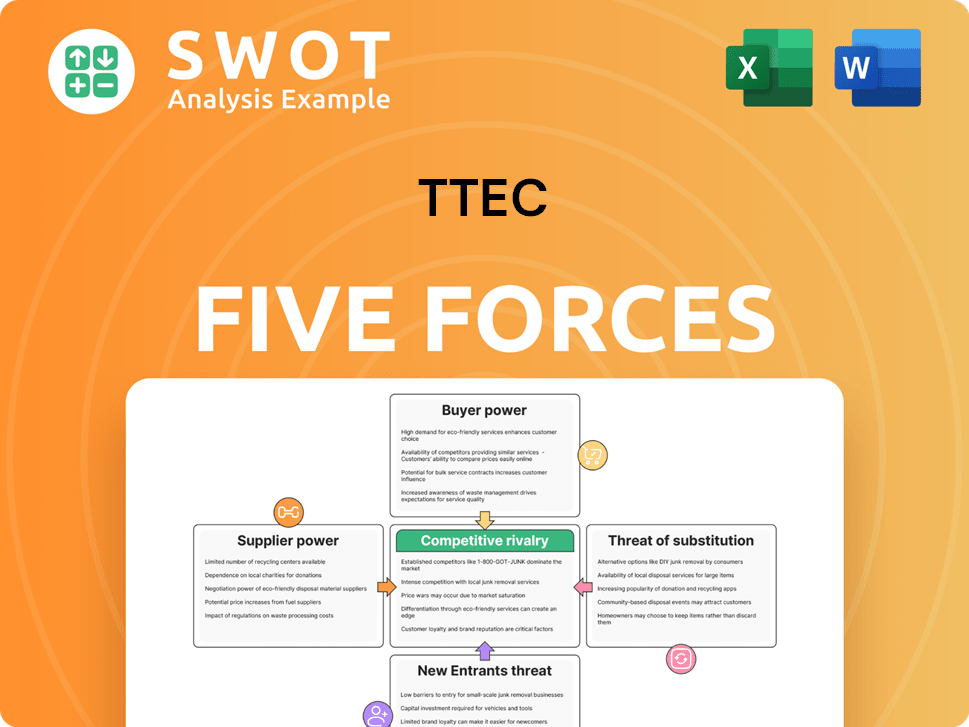
Related Blogs
- What are Mission Vision & Core Values of TTEC Company?
- What is Competitive Landscape of TTEC Company?
- What is Growth Strategy and Future Prospects of TTEC Company?
- How Does TTEC Company Work?
- What is Sales and Marketing Strategy of TTEC Company?
- What is Brief History of TTEC Company?
- Who Owns TTEC Company?
Disclaimer
All information, articles, and product details provided on this website are for general informational and educational purposes only. We do not claim any ownership over, nor do we intend to infringe upon, any trademarks, copyrights, logos, brand names, or other intellectual property mentioned or depicted on this site. Such intellectual property remains the property of its respective owners, and any references here are made solely for identification or informational purposes, without implying any affiliation, endorsement, or partnership.
We make no representations or warranties, express or implied, regarding the accuracy, completeness, or suitability of any content or products presented. Nothing on this website should be construed as legal, tax, investment, financial, medical, or other professional advice. In addition, no part of this site—including articles or product references—constitutes a solicitation, recommendation, endorsement, advertisement, or offer to buy or sell any securities, franchises, or other financial instruments, particularly in jurisdictions where such activity would be unlawful.
All content is of a general nature and may not address the specific circumstances of any individual or entity. It is not a substitute for professional advice or services. Any actions you take based on the information provided here are strictly at your own risk. You accept full responsibility for any decisions or outcomes arising from your use of this website and agree to release us from any liability in connection with your use of, or reliance upon, the content or products found herein.